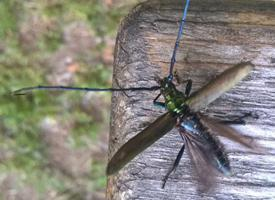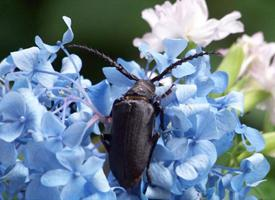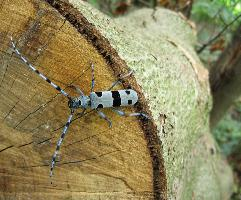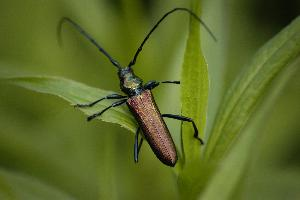
Váhy a míry
| Délka | 56 mm |
|---|
Popis zvířete
The Great Capricorn Beetle, scientifically known as Cerambyx cerdo, is a large and striking species of longhorn beetle that belongs to the Cerambycidae family. This species is notable for its impressive size, fascinating life cycle, and the role it plays in its ecosystem. It is primarily found across Europe and parts of Asia, inhabiting mature hardwood forests, especially those dominated by oak trees.Physical Description:
The Great Capricorn Beetle is one of the largest beetles found within its range, with adults typically measuring between 25 to 75 millimeters in length, although some individuals may grow even larger. The beetle's body is elongated and somewhat cylindrical in shape, characterized by a deep, dark brown to black coloration that can sometimes appear as a glossy black under direct sunlight. The antennae are exceptionally long, especially in males, where they can be twice as long as the body itself, while in females, they are roughly the same length as the body. These antennae serve as sensory organs, helping the beetle navigate its environment and find mates. The beetle's elytra (hardened forewings) are robust and textured, providing protection to the membranous flying wings underneath, although adults are not known for their flying prowess.
Life Cycle and Behavior:
The life cycle of the Great Capricorn Beetle is complex and can span several years from egg to adult. Females lay their eggs in crevices of dead or dying hardwood trees, particularly favoring oak. Upon hatching, the larvae bore into the wood, creating extensive galleries where they feed on the wood's nutrients. This larval stage is the longest phase of the beetle's life, lasting anywhere from three to five years, depending on environmental conditions. During this time, the larvae undergo several molts, gradually increasing in size. Once fully grown, the larva will pupate within the wood, emerging as an adult beetle several weeks later. Adults are primarily active during the warmer months, with their peak activity occurring in the late spring and summer. They are mainly nocturnal, coming out at dusk to feed on tree sap and to mate.
Ecological Role and Conservation Status:
The Great Capricorn Beetle plays a significant role in its ecosystem, primarily through its larval wood-boring activities. By decomposing dead and dying wood, these beetles contribute to nutrient cycling and the overall health of forest ecosystems. However, their dependence on mature hardwood forests makes them vulnerable to habitat loss and degradation due to deforestation, urbanization, and intensive forestry practices.
In many parts of its range, the Great Capricorn Beetle is considered a species of conservation concern. It is listed in Annex II of the EU Habitats Directive, which requires member states to designate Special Areas of Conservation to protect significant habitats and species. Despite these protections, the beetle's population continues to decline in areas where old-growth forests are disappearing.
In conclusion, the Great Capricorn Beetle is a fascinating and ecologically important species that symbolizes the ancient, undisturbed forests of Europe and Asia. Its presence indicates healthy, mature woodland ecosystems, but it also highlights the challenges of conserving such habitats in the face of increasing human pressure. Efforts to protect and restore its natural habitat are crucial for the survival of this remarkable beetle and the myriad of other species that depend on old-growth forests.
Podobná zvířata
Nové fotografie zvířat
Top 10 zvířat
- Chinese water dragon (Physignathus cocincinus)
- Dolphin gull (Leucophaeus scoresbii)
- Japanese macaque (Macaca fuscata)
- Galápagos tortoise (Geochelone nigra complex)
- Colombian red howler (Alouatta seniculus)
- Barbary macaque (Macaca sylvanus)
- Sea urchins (Echinoidea)
- Moustached guenon (Cercopithecus cephus)
- Diana monkey (Cercopithecus diana)
- Angolan talapoin (Miopithecus talapoin)


